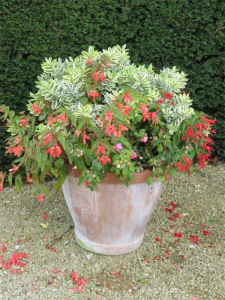
WITH barely a couple of weeks until the official start of spring there are early blossoms out in abundance, the first being Prunus mume or flowering apricot.

As local gardeners know, spring really starts in late September not the first day of the month. But that’s no reason to be complacent; there is much to be done in the garden to set the scene for colour from now until autumn.
The primulas, polyanthus and violas will continue to flower until well into September and here lies a problem. It takes at least eight weeks from the time the summer bedding plants, such as petunias, are planted until full flowering. So are the primulas and violas pulled out while still flowering, say, in the first week in September and replaced with petunias, which will then flower about early October?
Polyanthus can be left in and treated as a perennial simply by dead-heading and giving it a feed. Ideally, a combination of annuals and perennials works well.
INITIALLY, ground preparation is vital, whether it’s for annuals, perennials or trees and shrubs. For heavy clay soils adding a deep-penetrating liquid ground breaker such as the Maxicrop brand is preferable to, say, gypsum, which tends to remain only to the depth dug. The addition of washed river sand and any organic material such as compost, old leaves or decomposed manures will all help. When planting make sure not to dig up newly emerging spring or summer bulbs.
ANNUALS in particular require regular feeding. I cannot over-emphasise this point.
“I fed them when I planted them,” is the usual response when I am contacted about the poor showing of flowers.
I prefer liquid plant nutrients, as the goodness goes directly to the roots. With the delicate leaves of most annuals, using chemical pellets can cause severe burning of leaves. I use the certified organic Neutrog Seamungus, Multicrop Seaweed Plant Nutrient or Eco Seaweed in our garden, especially for growing edible crops.
I suggest a fortnightly feeding habit from the time of planting. Regular dead heading of spent flowers also encourages new blooms.
THE other pest for all garden plants is snails and it’s important to be extremely careful when using bait, especially when there are pets around. Years ago our cocker spaniel died after I had left a packet of one of the nasty varieties in our garden. The bran-based Multicrop Slug and Snail Killer is so much safer.
Snail-loving blue tongue lizards can also be killed from eating snail bait or slugs that have ingested bait.

SPRING is the time to think about repotting, especially plants that have been in the pot for years with roots possibly growing into the ground! Always buy pots with straight sides. Shaped, ornamental pots may look nice but trying to remove a plant, short of smashing the container, is almost impossible.
Jottings…
- For rosemary, plant Rosmarinus “Chef’s Choice” for the best flavour when cooking.
- Time is running out to get “bare-rooted” plants in the ground. Many plants, such as roses and berry plants, have only just been potted up in the last couple of months. Treat them as bare-rooted plants as the roots will hardly have had time to grow.
- Frosts are far from over, so keep citrus plants covered at night. *Well-known, English, TV gardener Monty Don has been awarded an MBE in the Queen’s UK Birthday Honours List.
Who can be trusted?
In a world of spin and confusion, there’s never been a more important time to support independent journalism in Canberra.
If you trust our work online and want to enforce the power of independent voices, I invite you to make a small contribution.
Every dollar of support is invested back into our journalism to help keep citynews.com.au strong and free.
Thank you,
Ian Meikle, editor




Leave a Reply